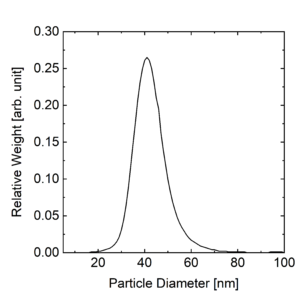Size Measurement of i-colloid Nanoparticles by Analytical Centrifugation
Size analysis of i-colloid nanoparticles is performed with a CPS disc centrifuge (CPS Instruments, Inc.), an instrument that separates particles by size via centrifugal sedimentation in a rotating disc containing a solvent density gradient. Particles moving at size-dependent rates toward the outer edge of the disc are continuously detected as they pass through a light source, and this data is converted to size distribution.
A particle’s settling velocity is proportional to the square of its diameter, and transportation time is calibrated with standard particles of uniform and known size (e.g. polystyrene beads). The overall size distribution is determined by sampling >1 x 109 particles, which is many orders of magnitude greater than other size determining methods which only sample hundreds to thousands of samples.
A direct comparison of CPS and the commonly-used TEM method shows good concordance between the two methods for both average size (<2 nm difference) and overall distribution for 40 nm i-colloid gold nanoparticles [Cederquist et al. Colloids Surf B Biointerfaces 149 (2017) 351-357]. An example of CPS output for i-colloid 40 nm gold nanoparticles is shown below.



